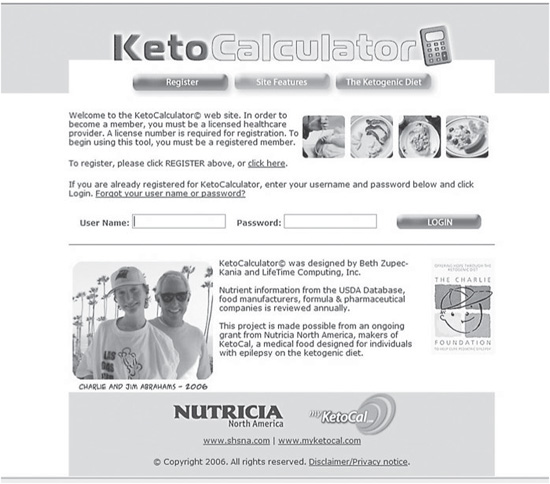
This chapter was written by Beth Zupec-Kania, RD, from The Charlie Foundation.
Computer technology is valuable in assisting with the management of diet therapies for epilepsy. KetoCalculator is a unique program that computes and stores diet information (see Figure 9.1). It was designed to calculate diets quickly whether you are in the middle of preparing a meal or are creating a series of new meals. The program is available online (www.ketocalculator.com), which makes it readily accessible wherever there is Internet access.
KetoCalculator may be used to create variations of the ketogenic diet. It has the flexibility to calculate the Ketogenic Diet ratios (5:1, 4:1, 3:1, 2:1) as well as the MCT oil diet, modified Atkins, and the LGIT (approximately 1:1). The program may be used to design diets for any age group and can be modified to the specific dietary needs of an individual. KetoCalculator can be utilized to create meals with baby foods, solid foods, liquid diets (formulas), or any combination of these.
The advantage to using an Internet-based system is that the food database is updated regularly. The database includes several hundred foods. The U.S. Department of Agriculture’s Food Composition Database is the main source of macronutrient data for natural occurring foods. Commercial food product information is obtained directly from the manufacturer. The carbohydrate content of medications and supplements is also obtained directly from the manufacturers.
FIGURE 9.1 Screenshot of www.ketocalculator.com.
KetoCalculator is intended for use by people who are under the supervision of a health care team, and some features of the program are only viewable to these professionals. The program is free to health care providers who are then able to grant access to families. Health care providers may register for the program via the Web site (www.ketocalculator.com). Once registered, a username and password are provided as well as instructions for navigating the program. The providers can then grant access to caregivers by creating a separate username and password. Access to the program is secure, and caregivers are only able to view their diet (and not the diets of other people). The following features are available through the caregiver access:

The menus that are provided in the program display gram weights of food that are specific to the Classic Ketogenic Diet and the MCT Oil Diet. These values may be converted to household measure for liberal diets, as shown in the table at the end of this chapter.
Prior to creating meals or snacks, the dietitian must enter a Diet Calculation. The diet calculation is tailored to the needs of the each individual and should be adjusted during the course of therapy by the dietitian. The Diet Calculation includes a calorie level, the ratio of the diet, and the appropriate amount of protein to provide the recommended dietary allowance (RDA) for the individual based on their weight and age. A sample Diet Calculation is shown in Table 9.1.
Once the diet calculation has been created, the total protein, carbohydrate, and fat are equally divided into the number of meals that are to be consumed daily. Three meals a day is the most typical diet plan, however, this can be tailored to the needs of the individual. For example, a 1-year-old may consume four meals daily.
TABLE 9.1
KetoCalculator Diet Calculation Screen
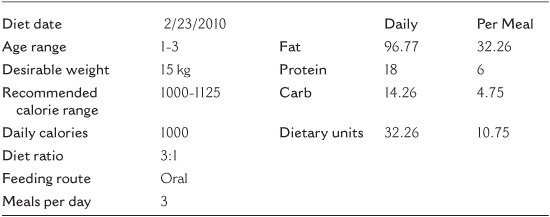
After the Diet Calculation is complete, the next step is to design meals.
The user may select from a list of Standard Meals. The Standard Meals are meals that are typical to the diet and consist of at least two foods that are high in fat, one high in protein, and one source of carbohydrate. The following list is a sample of the Standard Meals that are found in the program. Recipe instructions are included with certain meals.
Examples of Standard Meals
Breakfast sausage with fruit
Cheesecake
Chicken and spinach casserole
Chicken vegetable soup
Crabmeat salad with garlic dressing
Hot dog with vegetable
Lean meat with vegetable
Pork stir-fry
Scrambled eggs with avocado
Tuna salad with fruit
Once selected, the program automatically calculates the gram weight of each food in the meal; see Table 9.2.
This Standard Meal is created with the inclusion of two food groups. Group B vegetables are vegetables of similar carbohydrate content, and lean meat includes meat of similar protein and fat content. These food lists are assessable from the Handout link within KetoCalculator.
Meals may be individualized to suit preferences by changing the amounts of food using the up-down arrows. The user may also delete foods or add new foods to the meal. When these changes are made, the user must then manually correct the meal to match the recommended values shown at the bottom of the meal calculation.
TABLE 9.2
Example of a Standard Meal Top of Form
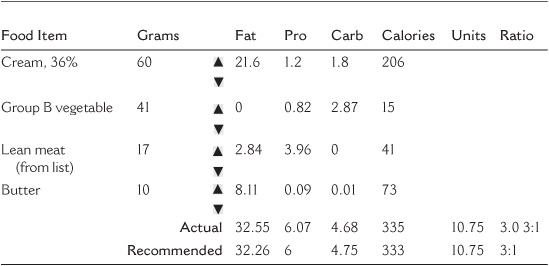
The example in Table 9.3 illustrates the standard meal shown in Table 9.2 meal with the addition of a new food. In order to account for the avocado that has been added to this meal, a reduction in the cream and butter has been made. The vegetable and meat have also been adjusted.
A single meal may be edited in numerous ways to suit the preference of the individual. For example, if the user wanted to choose a specific meat and vegetable instead of using the choices in the Standard Meal, the meal could be easily adjusted by deleting those items then adding new foods. Once these new foods are selected, the meal can again be edited to meet the recommended values at the bottom of the calculation.
When a user edits a meal, the dietitian is notified to review and verify these edits. This notification occurs in the Main Menu of the dietitian’s program. Once the dietitian has verified the meal, it becomes a printable meal. Without this verification, the meal cannot be printed. This is a cross-check system that helps to prevent the user from preparing meals that have not been reviewed. The printed version of the previous meal follows. Instructions may be added to the meals to clarify how the food items should be prepared.
Table 9.3
Example of a Standard Meal With Editing
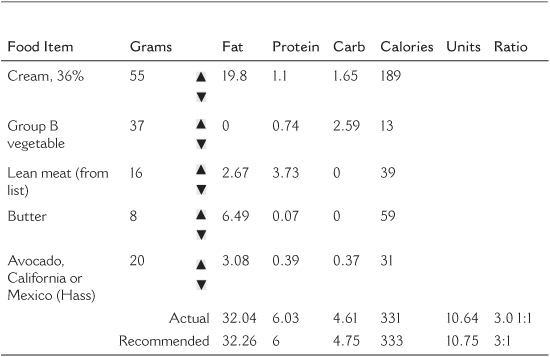
LEAN MEAT WITH VEGETABLE AND AVOCADO
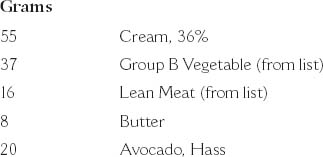
Instructions: Sauté sliced roast beef in butter in a small skillet until lightly browned. Pour remaining butter over warm vegetables. Serve cream as beverage or add diet caffeine-free root beer (free food). Serve sliced avocado with meat and vegetable.
In addition to meals, snacks can also be created in KetoCalculator. The calculation of a snack is similar to creating the calculation of the meals. It requires that the dietitian choose a calorie value and ratio. Standard snacks can be selected from a list of typical ketogenic snacks. They may also be modified to meet preferences. There are several innovative snacks recipes in this feature, which allows the user to test new items.
Table 9.4 is an example of a snack calculation for chocolate brownies. The recipe instructions (not shown) are provided with this snack. Once prepared, a brownie is cut to the gram weight identified to meet the desired calories and ratio.
The actual ratio of these brownies is 3.16:1, but this can be adjusted to a higher ratio, such as a 4:1, with the addition of fat, such as coconut oil or butter, into the snack calculation.
After creating several meals and snacks, the user may plan a calendar of menus using the title of the meal or snack. The Weekly Menu Planner feature is helpful for organizing meals and snacks for upcoming days or weeks. This is especially helpful when there is more than one caregiver involved in managing the diet. First, the user selects a date from the calendar, then is prompted to select from the list of meals or snacks that were previously created and verified. A week of meals is illustrated in Table 9.5. The number that appears after the meal titles references the recipe for the meal.
TABLE 9.4
Example of Adjusting Fat to Brownies in KetoCalculator

TABLE 9.5
Week of Meals on the Ketogenic Diet
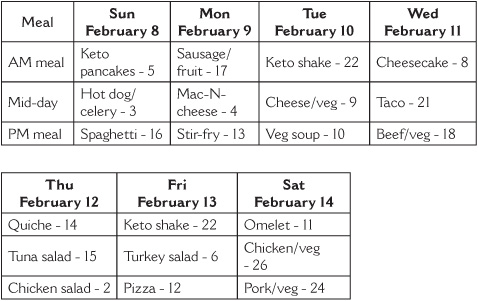
Another feature that assists caregivers with organizing the diet is the Fluid and Diet Schedule. This tool is intended to plan a daily routine of meal and snack times, nutritional supplements, medications, and beverages. It calculates the amount of fluid that is recommended for good health. The user can adjust the schedule during diet therapy as needed. This schedule is also available in a special format for individuals who are receiving their nutrition in liquid formulation, such as bottle feeding or feeding tubes.
KetoCalculator also includes supportive features to assist health care providers in the management of diet therapies. These are only viewable through the health care access.
• Vitamin and mineral supplement database with micronutrient and carbohydrate content
• Medication database with carbohydrate content
• Help Line; a question and response field for help with Keto-Calculator
KetoCalculator was designed in 2002 and has since received weekly editing and additions to its database, as well as annual updates to maintain the integrity of its digital framework. Use of this program has grown each year and is currently accessed by medical centers in 35 countries with several thousand users worldwide. Nutricia North America has provided the server space for this dynamic tool and has assisted with maintenance. Without their support, this program would not have been possible. For further information, you can email Beth Zupec-Kania at ketokania@gmail.com
Gram conversion to household measure
5 grams = 1 teaspoon (tsp)
15 grams = 1 tablespoon (tbl)
30 grams = 2 tablespoons
60 grams = 1/4 cup
120 grams = 1/2 cup
180 grams = 3/4 cup